Introduction and Quick Summary
If you’re looking for a vibrant and nutritious meal that’s both satisfying and easy to prepare, this Vegan Buddha Bowl with Tahini Dressing is the perfect choice. Packed with fresh vegetables, grains, and protein, it’s a delightful dish that appeals to everyone at the table. This recipe combines various textures and flavors that will awaken your taste buds while providing essential nutrients. Not only is it visually appealing with its colorful ingredients, but it also offers endless customization options.
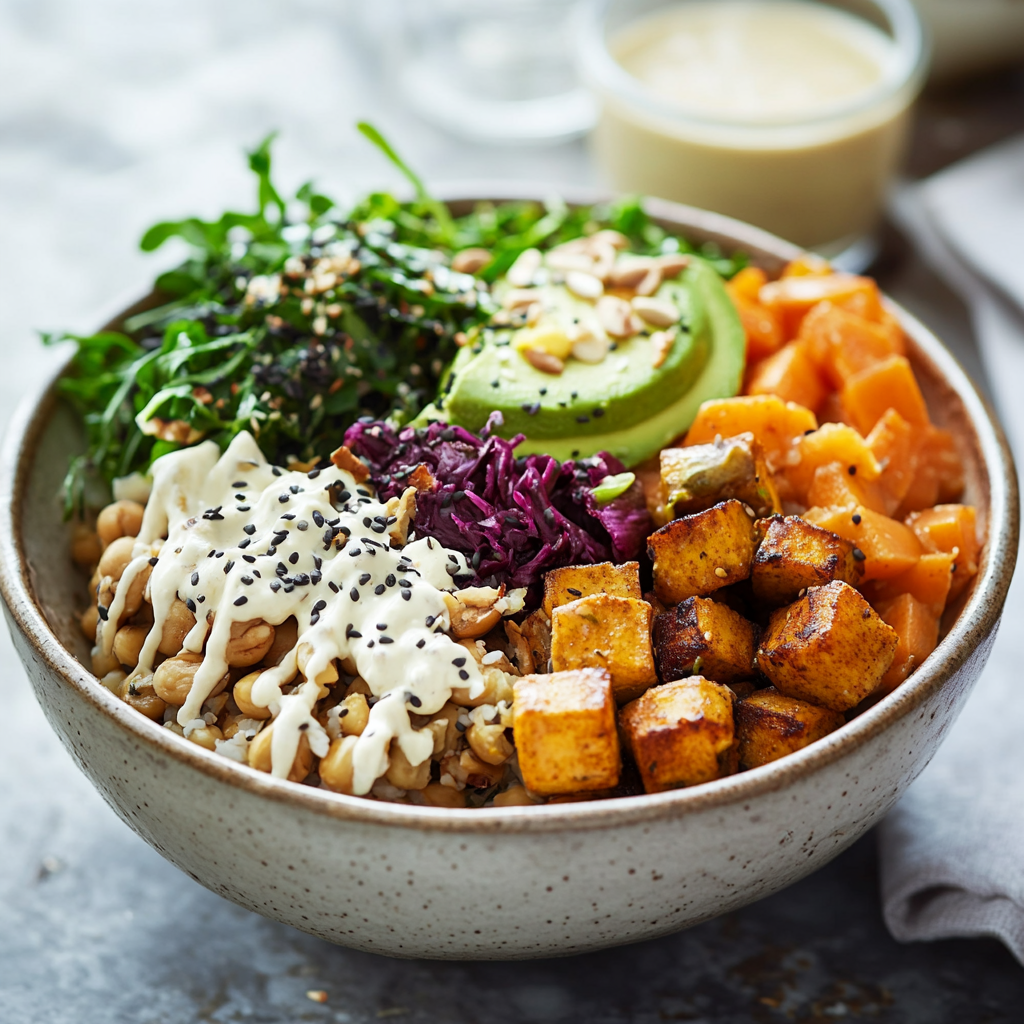
The beauty of a Buddha bowl lies in its versatility; you can use whatever vegetables or grains you have on hand. The star of the dish is the creamy tahini dressing that brings everything together with its nutty flavor. In just a few simple steps, you can whip up this delicious meal that’s perfect for lunch or dinner. Whether you’re meal prepping for the week or serving a family dinner, this recipe is sure to please. Let’s dive into the main ingredients that make up this wholesome Vegan Buddha Bowl!
Main Ingredients
Quinoa
Quinoa serves as the hearty base for this Vegan Buddha Bowl with Tahini Dressing. It’s packed with protein and fiber while being gluten-free. To prepare it correctly, rinse one cup of quinoa under cold water to remove its natural coating called saponin, which can impart a bitter flavor. Combine the rinsed quinoa with two cups of vegetable broth or water in a pot and bring it to a boil. Once boiling, reduce the heat and let it simmer for about 15 minutes until all the liquid is absorbed. Fluff it with a fork once done.
Spinach
Spinach adds vibrant color and essential vitamins to your bowl. Use about two cups of fresh spinach leaves in your recipe. You can either serve them raw for a crunchy texture or lightly sauté them in olive oil for a softer bite. If sautéing, cook until wilted—this usually takes about 2-3 minutes over medium heat.
Chickpeas
Chickpeas are an excellent source of plant-based protein and fiber. For this recipe, use one can (about 15 ounces) of chickpeas; drain and rinse them thoroughly before adding them to your bowl. You can serve them straight as they are or roast them for added crunch. To roast, toss chickpeas in olive oil and spices like paprika or cumin and bake at 400°F (200°C) for about 20-25 minutes until crispy.
Sweet Potato
Sweet potatoes not only add sweetness but also provide complex carbohydrates and nutrients like Vitamin A. Use one medium sweet potato; peel it and cut it into cubes. Toss these cubes in olive oil along with salt and pepper before roasting them in an oven at 425°F (220°C) for approximately 25-30 minutes until tender.
Avocado
Avocado enhances creaminess while contributing healthy fats to the meal. One ripe avocado will suffice for this recipe; simply slice it right before serving to maintain its freshness and avoid browning.
Tahini
Tahini is crucial for making the flavorful dressing that ties all elements of the dish together seamlessly. Use about ¼ cup of tahini mixed with lemon juice from one lemon, garlic minced (one clove), water to thin out if necessary, salt to taste, and any optional spices like cayenne pepper for an extra kick.
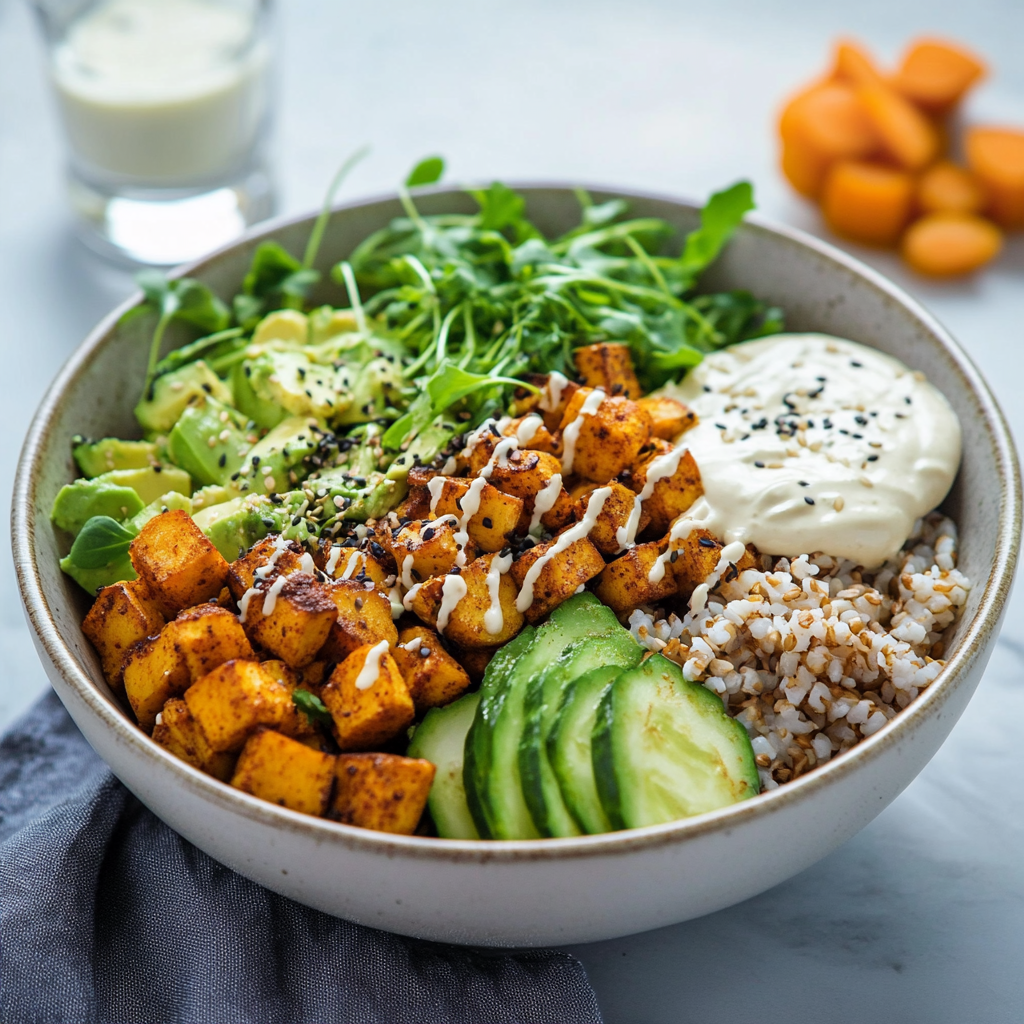
How to Prepare Vegan Buddha Bowl with Tahini Dressing
Step 1: Cook the Quinoa
Begin by preparing your quinoa as described earlier; rinse it well under cold water before cooking. In a medium saucepan over high heat, combine rinsed quinoa with vegetable broth or water at a ratio of 1: 2 (1 cup quinoa to 2 cups liquid). Bring it to a rolling boil then cover the pot with a lid once boiling begins; reduce heat to low so it simmers gently for about 15 minutes without lifting the lid during cooking time—this helps ensure fluffy quinoa! After cooking time is up, remove from heat but keep covered for another five minutes before uncovering; fluff gently using a fork.
Step 2: Roast Sweet Potatoes and Chickpeas
While your quinoa cooks away happily on the stove top, preheat your oven to 425°F (220°C). After peeling and cubing your sweet potato into bite-sized pieces as mentioned previously—place them onto a baking sheet lined with parchment paper along with drained chickpeas from their can (rinsed thoroughly). Drizzle both ingredients generously with olive oil along with salt & pepper then toss everything around evenly so that each piece gets coated nicely! Spread out evenly again on sheet ensuring no overlap occurs—this helps achieve optimal roasting conditions! Bake both items together in preheated oven for approximately 25-30 minutes until they become golden brown & tender upon tasting.
Step 3: Prepare Tahini Dressing
While waiting on roasted goodies in oven – let’s whip up our luscious tahini dressing! Start by measuring out around ¼ cup of tahini paste into small mixing bowl followed by freshly squeezed juice from one whole lemon (about two tablespoons worth). Add minced garlic clove along pinches of salt according personal preference! Using whisk or fork mix everything together vigorously until smooth consistency forms—if too thick at any point drizzle some water slowly while stirring continuously till desired creaminess achieved! Taste test & adjust seasoning if needed—add more lemon juice/salt according liking!
Step 4: Assemble Your Buddha Bowl
Once all components are ready—from perfectly cooked quinoa through roasted sweet potatoes/chickpeas alongside freshly sliced avocado—it’s time to assemble our beautiful Vegan Buddha Bowl! Start by spooning generous serving size cooked fluffed-up quinoa into bottom center portion large bowl then layer warm roasted veggies atop next alongside handful fresh baby spinach leaves arranged artfully around edges! Next comes sliced avocado placed strategically atop showcasing its gorgeous green color contrast against other vibrant hues present within dish! Drizzle creamy homemade tahini dressing generously over entire creation allowing flavors meld beautifully together!
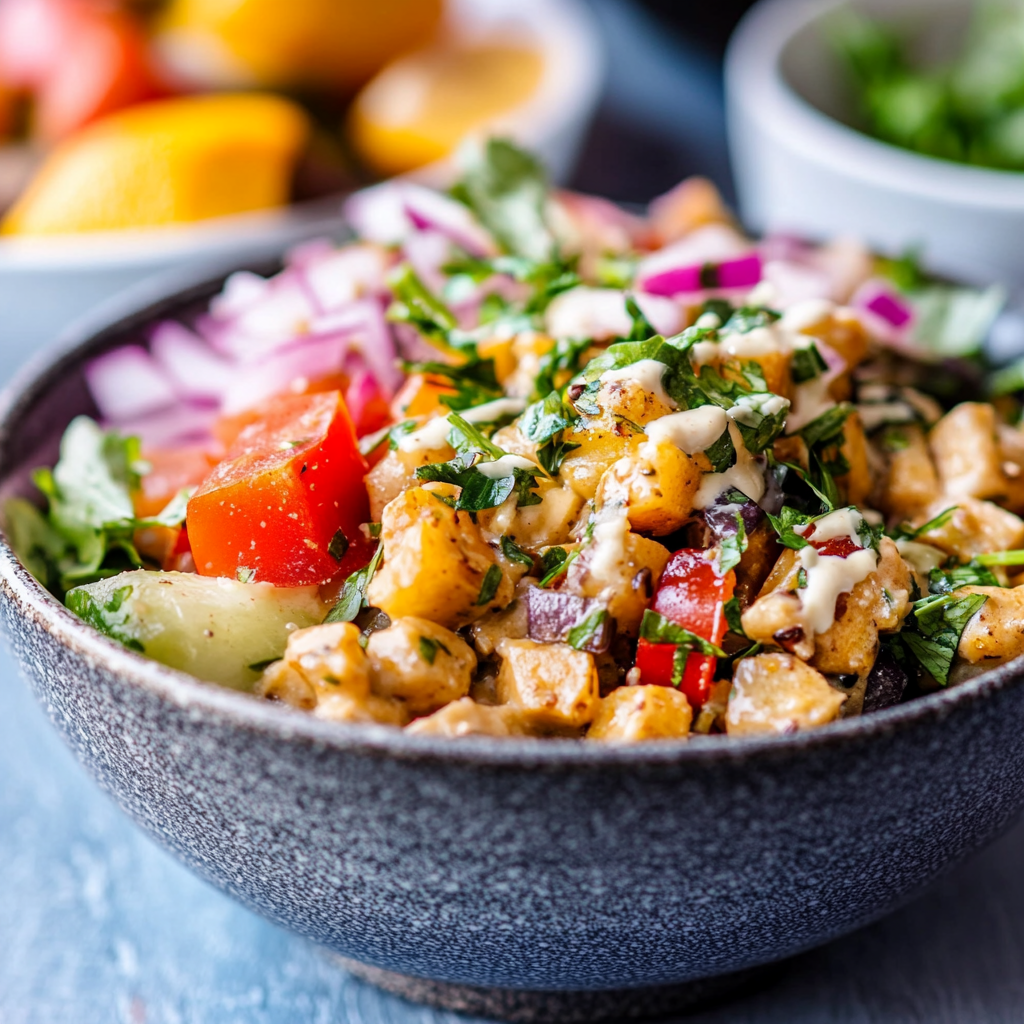
Serving and Storing Tips
Serving Suggestions
When serving your Vegan Buddha Bowl with Tahini Dressing, presentation is key! Place bowls onto colorful plates or wooden serving boards for added aesthetic appeal when sharing meals amongst friends/family members who gather round kitchen table together enjoying each other’s company over food shared lovingly prepared by hands-on chef behind scenes (that would be YOU!). Consider garnishing bowls further by topping off finished dishes sprinkled lightly toasted sesame seeds/chopped fresh herbs like parsley/cilantro providing additional flavor boost while enhancing visual charm tremendously!
Storage Instructions
If you have leftovers after enjoying this delightful meal—which might happen since it’s so delicious—you can store them conveniently using airtight containers in fridge where they’ll remain fresh roughly up-to three days maximum duration post-cooking session completed successfully! Just keep each ingredient separated if possible so textures remain intact upon reheating later down line – especially delicate avocado slices which tend brown quickly once cut open exposing flesh inside air contact surrounding environment nearby.
For best results when reheating stored components separately; reheat quinoa/chickpeas/sweet potatoes gently warming through microwave-safe dishes—and don’t forget drizzle some extra tahini sauce over everything prior digging back into deliciousness later on!
Enjoy creating this nourishing Vegan Buddha Bowl filled not just nutrition but warmth love shared through home-cooked meals made from scratch every step way enabling everyone partake experience indulging flavors simplicity offered here today!
Mistakes to avoid
One common mistake when preparing a Vegan Buddha Bowl with Tahini Dressing is not balancing the flavors and textures. A Buddha bowl should have a variety of ingredients that complement each other. For example, pairing creamy tahini dressing with crunchy vegetables creates a delightful contrast. Skipping on crunchy elements can make the dish feel monotonous. Always include a mix of raw and cooked vegetables, grains, and legumes to ensure an exciting eating experience.
Another mistake is overcooking the grains or vegetables. Grains like quinoa or brown rice should retain some texture, while veggies should remain vibrant and crisp. Overcooked ingredients can lead to a mushy bowl that lacks appeal. To prevent this, consider timing your cooking process carefully. Start by cooking grains first, as they take longer, and add vegetables near the end of the cooking time to keep them fresh.
Failing to season properly is another frequent oversight. A Vegan Buddha Bowl with Tahini Dressing needs seasoning at every layer for maximum flavor. This means salting the cooking water for grains and lightly seasoning vegetables before assembly. Don’t forget to taste as you go! The tahini dressing itself should also be adjusted to your preference—add lemon juice or garlic for extra zing.
Lastly, many people underestimate the importance of presentation. A well-arranged bowl is visually appealing and makes the meal more enjoyable. Pay attention to how you layer your ingredients in the bowl. Use contrasting colors and arrange items in a way that showcases their textures. Taking these small steps can elevate your dish from ordinary to extraordinary.
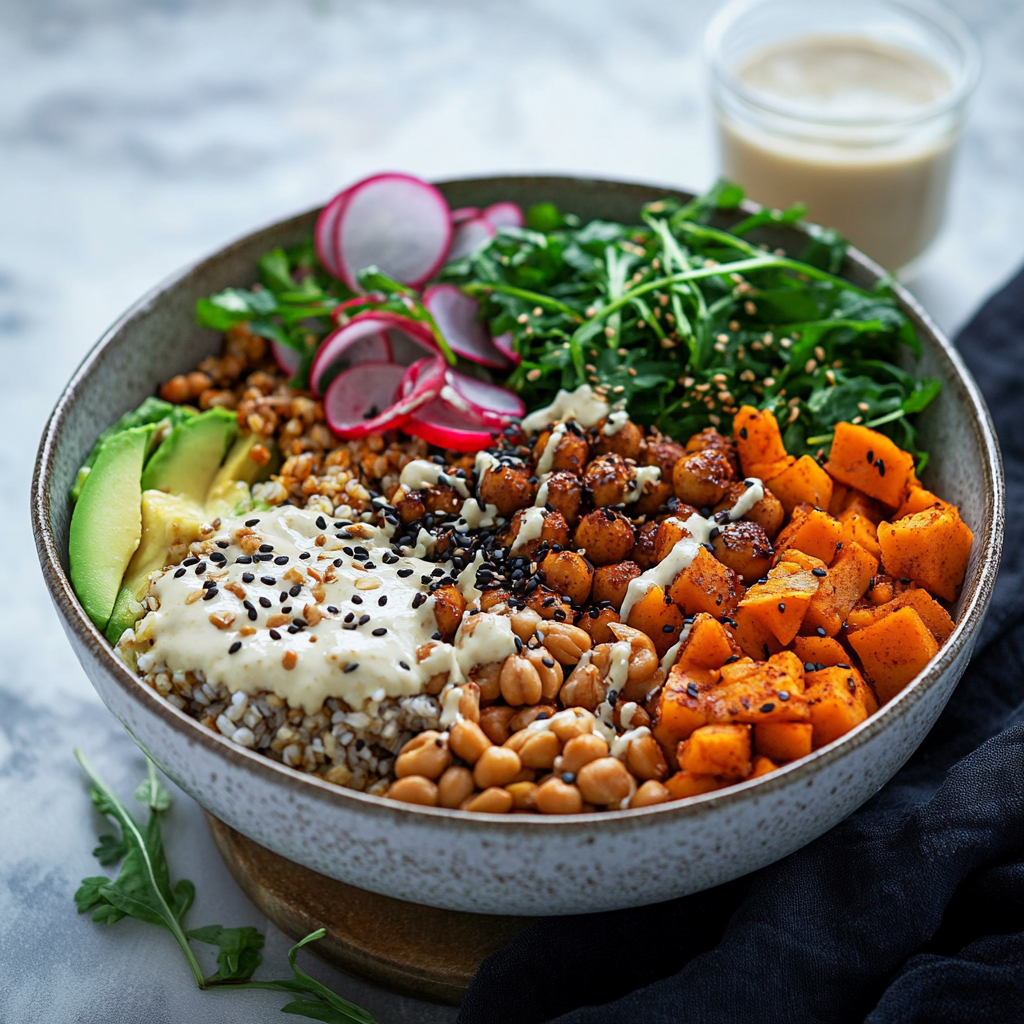
Tips and tricks
To create an outstanding Vegan Buddha Bowl with Tahini Dressing, start by selecting seasonal vegetables. Fresh produce not only enhances flavor but also ensures you’re using nutrient-dense ingredients. Visit local farmers’ markets or grocery stores to find what’s in season. Seasonal veggies often taste better and can inspire your flavor combinations.
Consider incorporating different grains for variety in texture and nutrition. While quinoa is a popular choice, alternatives like farro or millet can add unique flavors to your bowl. Mixing different grains can also enhance the nutritional aspect of your meal by providing diverse vitamins and minerals.
When making tahini dressing, remember that consistency matters. If it’s too thick, it may not coat all components of your bowl evenly; if it’s too thin, it won’t have enough flavor impact. Adjust with water gradually until you reach your desired consistency without losing richness in flavor.
For added protein, include legumes such as chickpeas or lentils. They not only boost protein content but also contribute fiber which keeps you satiated longer. Roasting chickpeas with spices prior to adding them to your bowl can give an unexpected crunch that elevates your dish further.
Don’t forget about garnishes! Adding toppings like sesame seeds or chopped herbs can elevate visual appeal while enhancing flavor profiles significantly. These small touches make a big difference in how enjoyable your Vegan Buddha Bowl becomes.
Suggestions for Vegan Buddha Bowl with Tahini Dressing
A great suggestion for a Vegan Buddha Bowl with Tahini Dressing is to incorporate healthy fats through avocado or nuts. Avocado adds creaminess while providing essential fatty acids, which help absorb nutrients from other ingredients more effectively. Nuts like almonds or walnuts offer crunch and additional protein while enhancing overall nutritional value.
Think about including fermented foods as well; they promote gut health and add complexity in taste through tanginess. Foods such as kimchi or pickled radishes work excellently when mixed into a Buddha bowl because they complement tahini dressing beautifully while offering probiotic benefits.
Another suggestion is layering flavors throughout the assembly process rather than dumping everything into one bowl at once. Start by putting down a base grain layer followed by seasoned vegetables and legumes; drizzle tahini dressing incrementally rather than all at once while assembling each component for balanced flavor distribution.
Experimenting with different tahini dressing variations can also spice things up! Try incorporating herbs like cilantro or parsley into your tahini for fresh notes; adding spices such as cumin or smoked paprika introduces depth that transforms standard dressings into something special.
Finally, consider meal prepping components ahead of time for quick assembly on busy days! Prepare grains, roast veggies, make dressings – storing these separately allows you to whip up satisfying bowls effortlessly throughout the week.
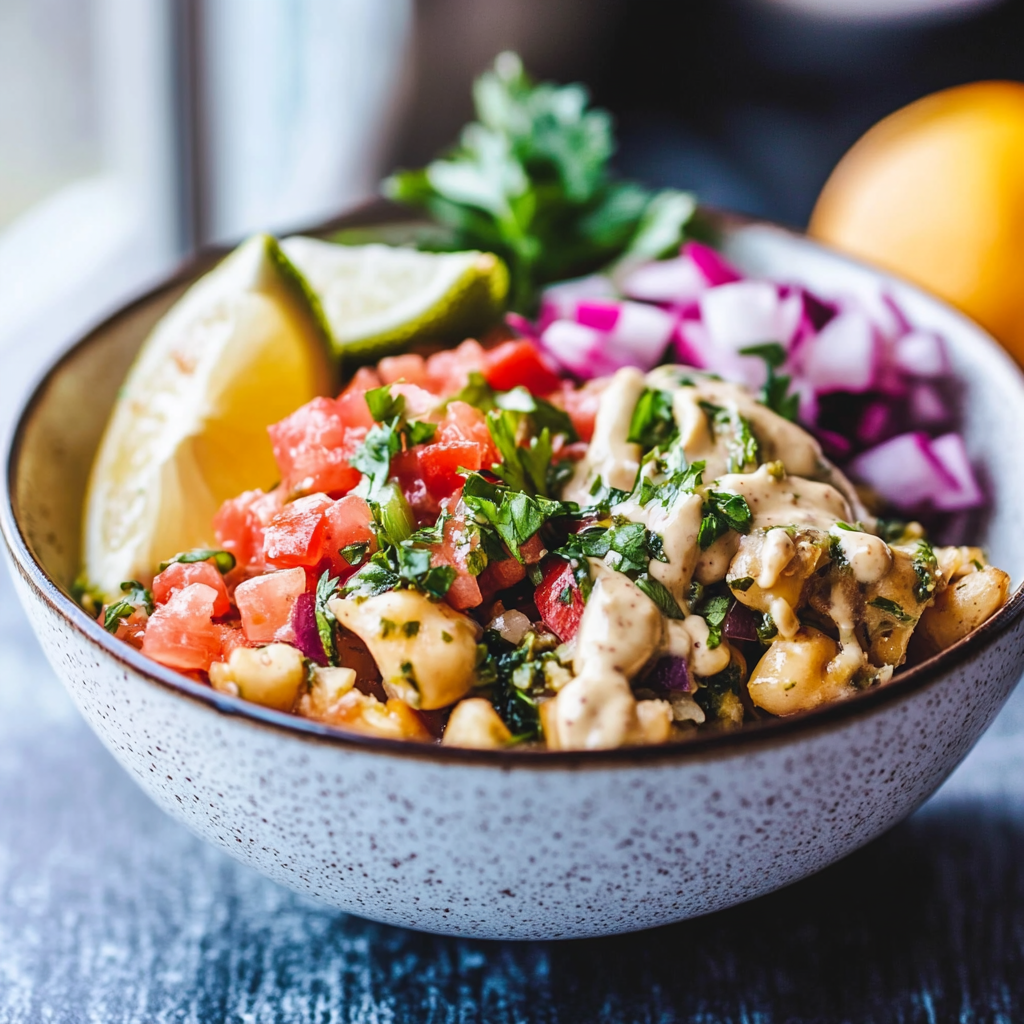
FAQs
What are the main ingredients in a Vegan Buddha Bowl with Tahini Dressing?
The main ingredients typically include various fresh vegetables, whole grains like quinoa or brown rice, legumes such as chickpeas or black beans, nuts or seeds for added crunch, and of course, tahini dressing made from sesame paste mixed with lemon juice and garlic for flavor enhancement.
Can I customize my Vegan Buddha Bowl?
Absolutely! One of the best aspects of a Vegan Buddha Bowl is its versatility; you can swap out ingredients based on personal preferences or seasonal availability without compromising its essence. Feel free to experiment with different grains, vegetables, proteins, and dressings until you find combinations that suit your palate perfectly.
How do I store leftovers from my Vegan Buddha Bowl?
For optimal freshness when storing leftovers from your Vegan Buddha Bowl with Tahini Dressing, separate components such as grains and veggies from sauces like tahini dressing until ready to eat again; this prevents sogginess while maintaining texture integrity during storage times lasting 3-4 days refrigerated safely within airtight containers.
Is this recipe suitable for meal prep?
Yes! Preparing individual components ahead of time makes it easy to assemble nutritious meals throughout the week effortlessly; cook larger batches then portion them out into containers ensuring versatile options are available whenever hunger strikes without sacrificing quality nutrition!
How do I enhance the flavor of my tahini dressing?
Enhancing flavor in tahini dressing can be achieved by adding various elements such as minced garlic cloves for zingy notes along with citrus juices (like lemon), sweeteners (like maple syrup), spices (like cumin), or even fresh herbs (like parsley) creating layers that elevate its taste profile significantly!
Can I use other dressings instead of tahini?
Certainly! While tahini dressing provides unique creaminess paired excellently within vegan bowls alternative options might include hummus-based dressings avocado-lime vinaigrettes yogurt-based sauces (non-dairy) allowing endless possibilities depending on dietary restrictions/preferences tailoring dishes according accordingly!
Conclusion
Creating a delicious Vegan Buddha Bowl with Tahini Dressing requires careful consideration of both flavors and presentation techniques while avoiding common mistakes that could detract from enjoyment levels overall! By focusing on balancing textures along with proper seasoning practices alongside ingredient selection—one ensures each bite remains exciting yet nourishing throughout meals prepared regularly! Furthermore utilizing suggestions ranging from incorporating healthy fats/fermented foods through creative layering methods enhances experiences enjoyed daily significantly transforming simple recipes into gourmet delights worthy savoring moments shared together!




